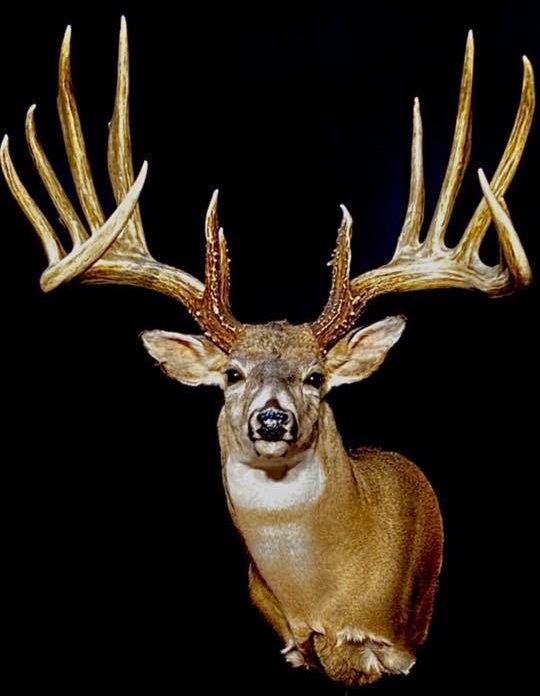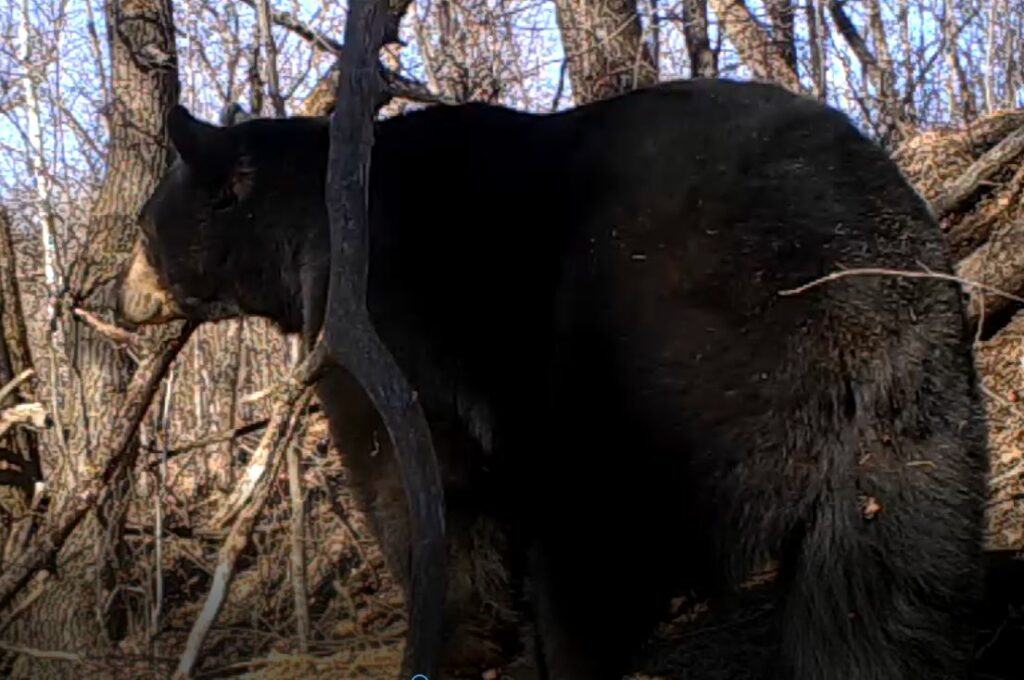The biggest typical whitetail ever to walk the earth?

By Bernie Barringer Hundreds of factors must come together in one shining moment for a buck to reach world record caliber. A long line of big antler genetics must funnel down through the generations into one female deer. This doe must have hit the genetic lottery with a series of big buck sires in the females of her family tree. Then she must breed with a gigantic buck and she must produce a buck fawn, otherwise, all this genetic information will have to be delayed one more year. Then, of course, this buck fawn must escape the myriad pitfalls that lay out before him. He must escape coyotes, cars, farm equipment and of course hunters. He must live an idyllic lifestyle in comfort with excellent nutrition readily available, and he must do this for five or six years. If all these things come together, out walks a buck carrying a rack larger than the millions and millions of bucks who have come before him. This all happened on a ranch in Nebraska in the 1950s. A rancher who will remain unnamed had seen three gigantic bucks on his property during the fall of 1958. There was no hunting in Nebraska at that time, the first modern day hunting season for whitetails would not occur until the following fall of 1959. Whitetails had been off limits for half a century and they were expanding their population. The age structure was balanced, with many mature bucks. In the spring of 1959, this rancher was tending to his cows, which were calving at the time. He walked into a patch of brush to retrieve a newborn calf and discovered two gigantic shed antlers lying a few feet apart. He later sawed off the back of the burrs so they would fit flat against a wall and screwed them above a doorway in a back room of his farmhouse. There they hung for many years. In the mid-1990s, an outfitter named Tim Condict was talking to ranchers in the area about leasing land for hunting when he asked a rancher if he had any big racks or shed antlers lying around. The rancher said, “No, but the neighbor across the way has a set you aren’t going to believe. I’ve seen the big bucks in the Cabela’s store and they ain’t got nuthin’ like this one!” That led Tim to the set of sheds that would become known as The General, the largest typical sheds of all time. Details of the transaction which caused those antlers to leave the farmhouse for the first time in 37 years are not known, but the gigantic buck would finally become known to serious whitetail collectors and big buck lovers. The buck’s main beams are both over 32 inches and mass measurements are as high as 7-1/2. When mounted in a position that they look natural, they have an inside spread of nearly 24 inches. As it is, the buck scored 240 gross typical and nearly 219 net, more than five inches larger than the current Saskatchewan world record held by Milo Hanson. But the shrinking effects of a warm, dry Nebraska farmhouse have taken a large toll. No one, of course, knows exactly how much, but many antler collectors have some estimates. Antler collector Dick Idol said about the buck, “It’s hardly fair to compare such a rack to a recently harvested one kept indoors from the time of skinning for the short 60-day drying period and then officially measured for the record book. Just in shrinkage alone, these Nebraska sheds could easily have lost as much as 6 to 8 inches in total measurement, especially in this type of rack, which still has 32-plus-inch main beams and a conservative inside spread of nearly 24 inches. Another 8 to 10 inches overall, which this buck conceivably lost, would have put him at 226 1/8 to 228 1/8 net, had the antlers been measured soon after being found back in 1959.” There have been some other giant sheds found that would be contenders for the world record if the buck was shot by a hunter. The “Kansas King” theoretically scores 217 as a typical with a spread credit included. One of side a giant Iowa buck was found that scored 112 typical. Even with a small spread credit of 20 inches you are looking at a 244 gross typical. It makes you wonder what might have been. And is there a buck out there now that hit the genetic lottery? One as big or bigger than The General?
Lessons Learned From a Bear Den

By Bernie Barringer My buddy Rick called me one day in December and said he had found a bear in a den along a river bank. He’d been setting snares for fox and coyotes when he came across a set of large bear tracks in the snow, so he followed them and discovered the den. Looking into the large hole, he could see the bear. I got very excited about it because I had never found a bear in a den before and I had always thought it would be cool to put a trail camera on a bear den to see what I could learn. I have a lot of experience hunting bears, I am a field editor for Bear Hunting Magazine and I have an appetite to learn more about this creature that has fascinated me since I was a teenager. Rick took me out to show me the den and I hung a Covert Scouting Camera on a tree right near the mouth of the den. I set the camera to take 30-second videos on a 5-minute timer each time movement triggered the camera. After mounting the camera, I slowly crept up the mound of dirt in front of the hole and I was surprised to see the bear looking at me. I snapped a couple quick photos and hustled out of the area. The hole was about 40 inches in diameter, and the bear was curled up about five feet below the entrance. I was surprised that there was nothing between the bear and the cold air. Temperatures of 30-40 below zero are common here in January and February, so I was intrigued that the bear had not made any effort to block the entrance of the hole. About the end of February, we had an unusually warm spell with temperatures well above freezing so I headed out to check the camera. I changed the SD card and then crept up again to look into the den. Sure enough, the bear was looking right up at me. That’s a little unnerving looking a bear right in the eye from about eight feet away. I discovered that the bear had poked his head out of the den and looked around every day during this warm spell. At one point, he came all the way to the top of the dirt mound, but the video showed clearly that he could barely stand. The bear was an adult male and quite large, probably at least 350 pounds even after not eating for about four months. I discovered that the camera was pointed a little off from where I would like, so when the temperatures dropped back to near zero, I crept back out there and hung a second camera facing more up the hill above the den hole. By the time the middle of March rolled around, the days were getting warmer and the snow had melted. I wanted to go get the cameras, but when I went out there, I could see through binoculars that the bear was lying near the mouth of the den only a few feet from the cameras. I decided to play it safe and I waited until April 19 to retrieve the camera, when I felt confident that the bear would be gone. Sure enough, he was gone and the hole had collapsed. I had more than 350 short videos of the bear coming out of the hole on warm days and moving about. As you can see by the accompanying video, he started out very wobbly, but within a few days of moving around the mouth of the den, he was back up to speed. I learned a lot, and most surprising to me was that the bear was so easy to wake up, and came out of the hole most every day for about three weeks before he actually left the den for good. I trust you will enjoy the video and find it a learning experience as I have.
